Picking the right combo of wooden furniture and hardwood floors can totally change the mood of a room. So many homeowners get stuck on whether their furniture should match their floors or stand out against them.
Remember to repin your favorite images!
Honestly, what matters most is understanding some design basics—contrast, complementary tones, and mixing up textures. Forget about trying to match everything perfectly.
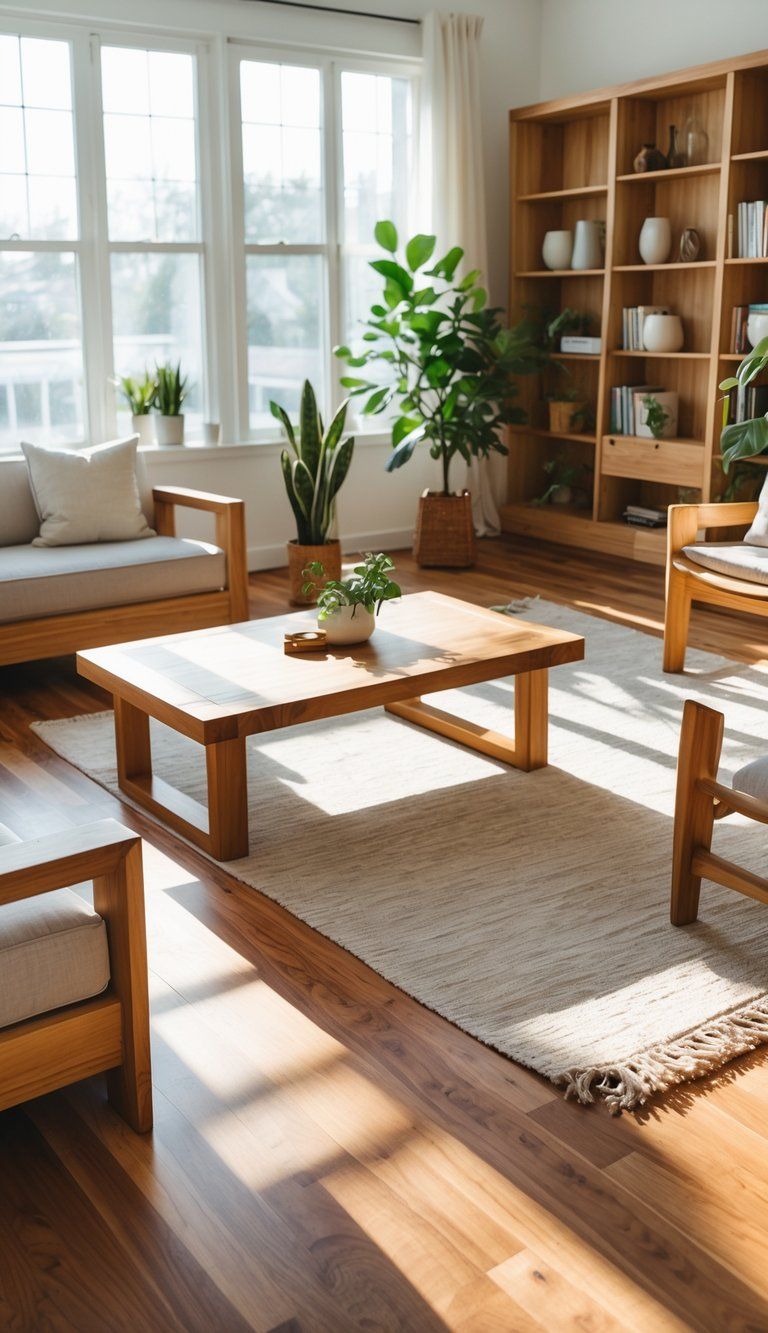
Think of wood elements in your home as family, not identical twins. They don’t have to look exactly alike to belong together.
You’ll often get better results by balancing things out with contrast. Dark furniture makes light floors stand out, and lighter wood pieces can soften up a space with darker flooring.
Texture matters too. A smooth, glossy table might feel off if your floors are also shiny, but it’ll look great with matte floors.
Lighting really brings out the best in your wood combinations. It highlights the natural warmth and beauty that make wood such a timeless choice for any home.
Understanding Wood Tones and Undertones
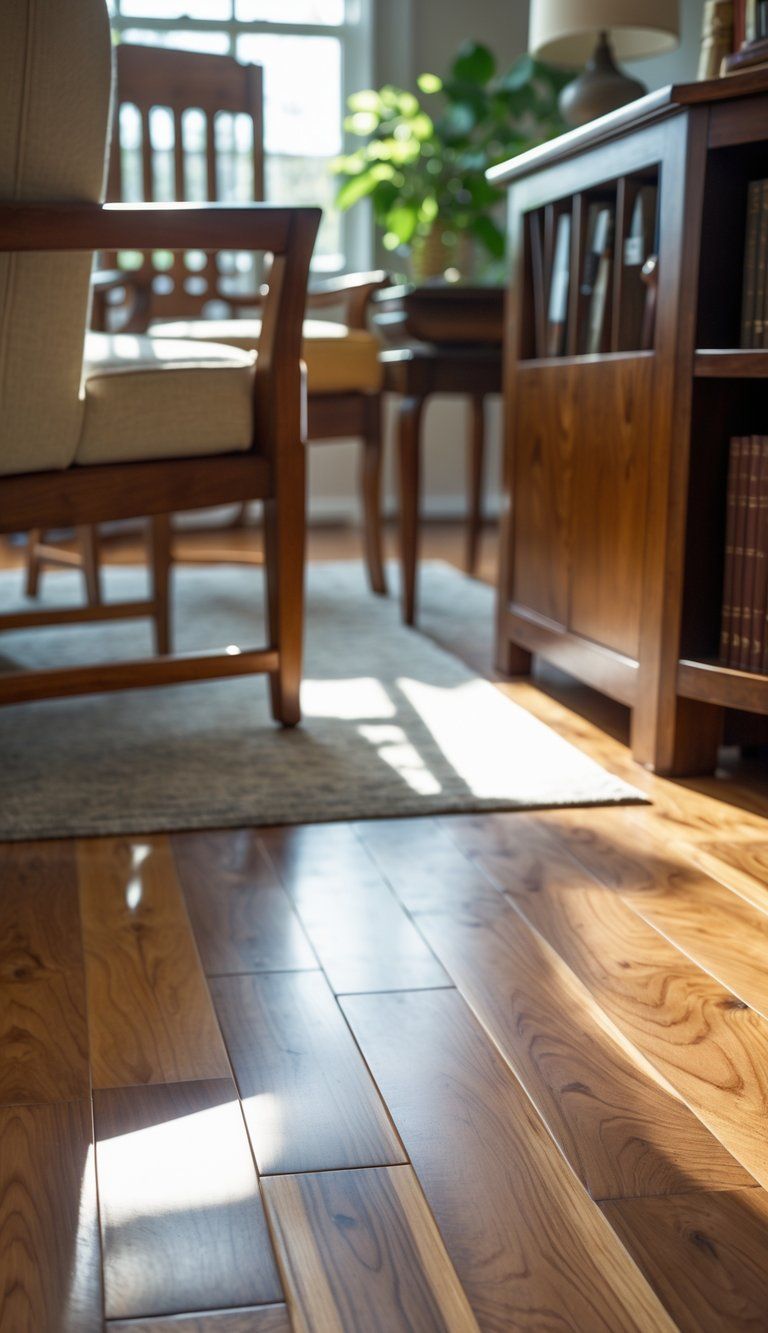
Wood tones set the stage for your room’s color palette. Every piece of wood—furniture or flooring—has a main color and an undertone that really impacts how everything fits together.
Warm, Cool, and Neutral Undertones
Warm undertones show up as red, orange, or yellow. Cherry, mahogany, and oak usually have warm undertones, which makes a room feel cozy and inviting.
Cool undertones lean toward gray, blue, or green. Ash, some maples, and certain walnuts fit this vibe, which feels more modern and calm.
Neutral undertones fall somewhere in the middle. Natural maple and some pines don’t really lean warm or cool. These woods are super versatile and can help bridge different wood tones in your space.
Quick tip: Set wood samples side by side in natural light. You’ll spot their undertones way easier that way.
Identifying Wood Tones in Furniture and Flooring
Wood tones usually fall into three groups:
- Light tones: Maple, ash, pine, birch
- Medium tones: Oak, cherry, teak
- Dark tones: Walnut, mahogany, ebony
To spot undertones in your wood:
- Check the wood in natural daylight.
- Place a plain white paper next to it.
- See if you notice reddish, yellowish, or grayish hints.
Floors usually set the dominant wood tone since they cover so much space. Use your flooring as a starting point for picking out furniture.
How Undertones Affect Overall Room Aesthetics
Undertones really change the mood of a room. Warm woods make things feel traditional and cozy, especially paired with earthy colors and brass or bronze.
Cool woods give off a more contemporary, calming vibe. They look great with blues, greens, and silver or chrome accents.
If you want to mix undertones, go slow. Too many clashing wood colors can make a room feel chaotic. For a relaxed look, stick with similar undertones or make a deliberate contrast between light and dark woods.
Designer move: Throw in a medium-toned wood piece to bridge the gap between very light and very dark woods.
Lighting changes everything. North-facing rooms bring out cool undertones, while south-facing spaces make warm tones pop.
Types of Hardwood Floors and Wood Species
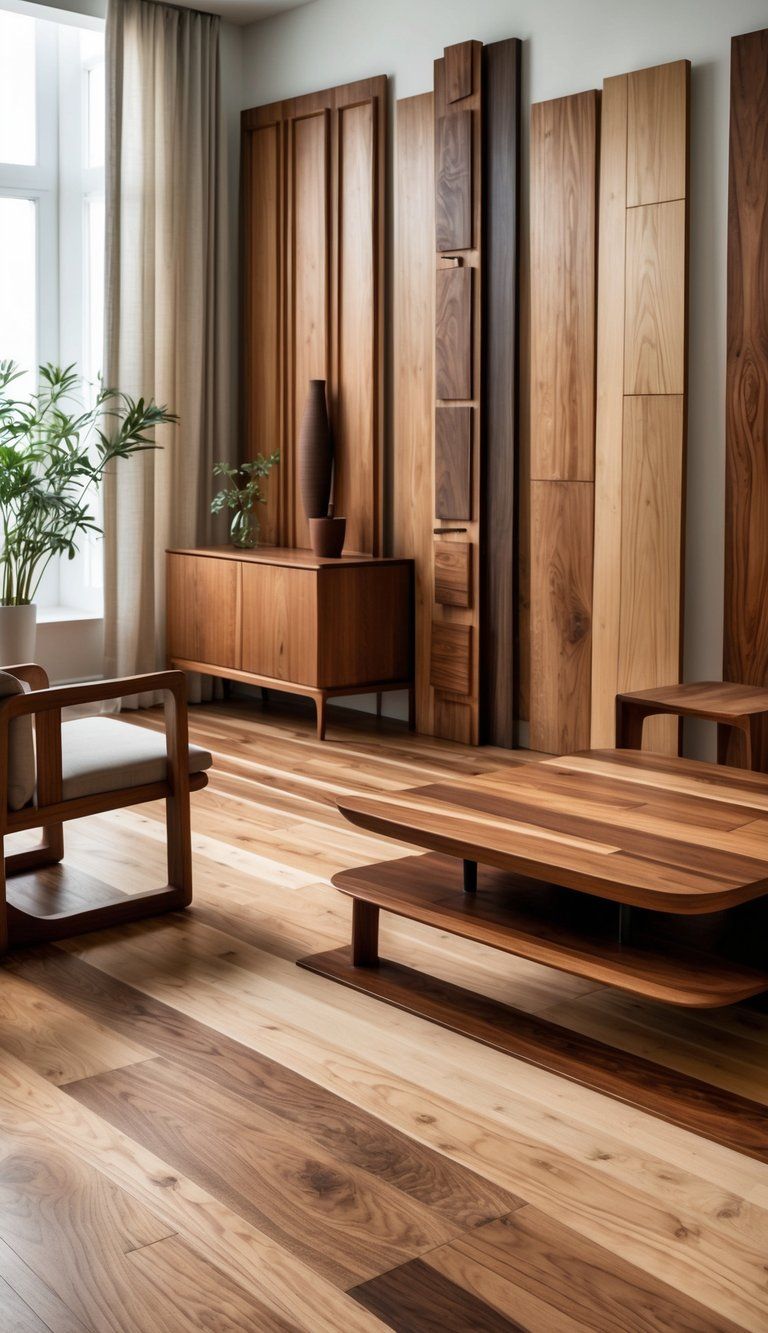
Picking the right hardwood floor can make or break your interior design. Knowing the different types of wood floors and what sets them apart helps you match or contrast furniture more confidently.
Common Wood Species: Oak, Walnut, Cherry, and More
Oak is a classic favorite for hardwood flooring. It’s tough and has a unique grain pattern. Red oak brings pink undertones, while white oak leans golden. Oak fits well in busy areas and works with almost any style.
Walnut gives you a deep, chocolatey color and instant sophistication. It’s softer than oak but has a striking grain that a lot of people love. Walnut floors look awesome with lighter furniture.
Cherry starts off lighter but darkens to a rich reddish-brown over time. Its warmth pairs especially well with traditional furniture.
Other good picks:
- Maple: Pale with subtle grain
- Hickory: Super hard, lots of grain variation
- Ash: Like oak but with even more character in its grain
Laminate and Engineered Alternatives
Engineered hardwood uses a real wood veneer over plywood layers. This makes it more stable than solid wood, especially where humidity changes a lot. You can put engineered wood in basements or over concrete—places where solid wood just doesn’t work.
Laminate flooring is budget-friendly and surprisingly realistic these days. It’s tough against scratches and dents, perfect for homes with pets or kids.
Both options come in tons of wood looks, from oak to more exotic styles. The main difference: engineered floors have real wood on top, laminates just have a printed image. That affects how well they pair with actual wooden furniture.
Grain Patterns and Texture Differences
Wood grain changes everything about how your floors look next to your furniture. Plain-sawn (flat-sawn) wood shows bold, dramatic grain—think big arches. It’s great for a more casual feel.
Quarter-sawn wood displays straighter, more even grain lines with cool flecks. It’s sturdy and doesn’t warp easily, so it’s popular in craftsman or mission-style spaces.
Rift-sawn lumber gives you the straightest grain with almost no flecks. That modern, clean look goes nicely with contemporary furniture.
Texture matters too. Hand-scraped or distressed floors have character marks that lean rustic. Smooth, polished floors feel more refined and suit modern furniture best.
How to Match Wooden Furniture with Hardwood Floors

Matching your wooden furniture and hardwood floors doesn’t have to be overwhelming. If you know a few simple design tricks, you can make your space feel intentional and pulled together.
Choosing Complementary Wood Finishes
Finishes can totally change how your furniture looks next to your floor. Matte finishes give off a laid-back vibe, while glossy ones feel more formal.
Try mixing things up. If your floors are super shiny, pick furniture with a matte or satin finish to avoid glare overload.
Distressed or hand-scraped furniture works well with similarly textured floors in rustic rooms. In modern spaces, smooth finishes keep things sleek.
Finishes also change how light bounces off wood, so your colors might look different throughout the day.
Matching Wood Tones for a Cohesive Look
Matching wood tones exactly isn’t necessary. In fact, pairing light furniture with dark floors (or the other way around) often looks better.
Light oak furniture on deep walnut floors? It’s a classic contrast that always works. Mahogany pieces really pop against pale maple or ash floors.
If you want everything to flow, stick with furniture that shares the same undertones as your floor. Warm undertones go together, and cool undertones do too.
Look at the wood grain. Big, bold grain on furniture can balance out subtle floor patterns, so nothing fights for attention.
Coordinating Color Palettes
Your color scheme ties it all together. Wall colors can help bridge the gap between furniture and floor tones.
Go for neutral walls—beige, cream, or soft gray. They’re flexible and work with most wood combos.
Accent colors matter. If your wood is mostly warm, cool-colored accessories (like blue or green) add contrast. Cooler woods benefit from warm accents (think reds or yellows).
Textiles—rugs, curtains, upholstery—can pull colors from both your furniture and floors, connecting everything visually.
Lighting changes how wood colors look, so check your picks in both daylight and evening light.
The Art of Contrasting Wooden Furniture with Floors
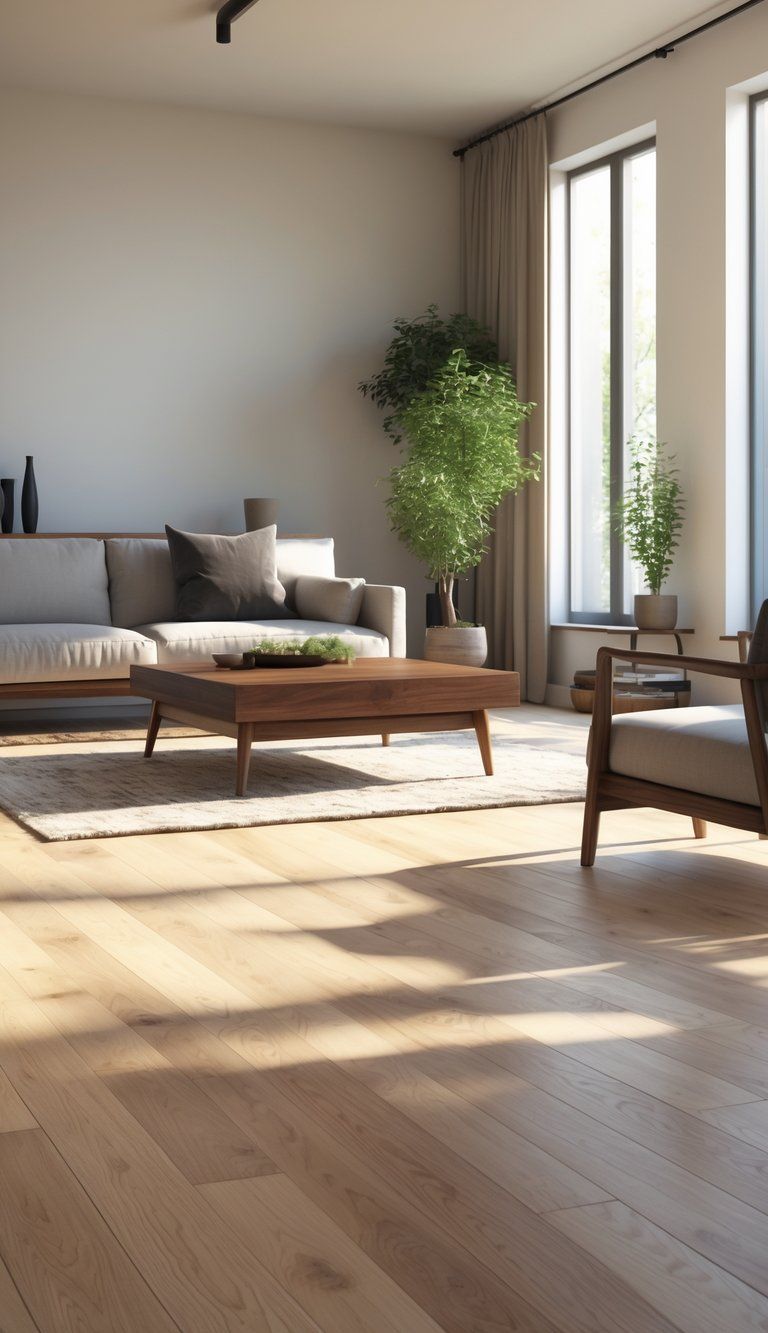
Mixing wood tones adds depth and interest to your rooms. When you get it right, dark and light woods can really make each other shine.
Best Practices for Contrasting Wood Tones
When you mix wood tones, pay attention to the undertones. Most woods lean warm (red, orange, yellow) or cool (gray, blue).
For a balanced contrast:
- Pair woods with the same undertones but different shades
- Mix fine-grain furniture with bolder-grain floors
- Stick to two or three wood finishes in a room
- Use area rugs to buffer strong contrasts
Natural light shifts how wood looks. Test your combos at different times of day before you commit.
Keep your walls and décor neutral to let the woods stand out without clashing.
Dark Wood Furniture on Light Floors
Dark furniture becomes the star on light floors. This combo makes rooms feel grounded but still spacious.
On maple, ash, or light oak floors, try:
- Walnut (deep brown, purple undertones)
- Mahogany (rich, reddish-brown)
- Espresso-stained pieces (almost black)
Light floors bounce light around, so dark furniture doesn’t make things feel cramped. This look shines in:
- Living rooms with lots of windows
- Dining rooms where the table is the main event
- Home offices with a bold, dark desk
Metal accents like brass or chrome help bridge the gap between dark furniture and pale floors.
Light Wood Furniture on Dark Floors
Light wood furniture on dark floors feels fresh and modern. It brightens up spaces that might otherwise seem heavy.
Good picks for light furniture:
- Maple (creamy, subtle grain)
- Ash (light, with distinct grain)
- Bleached oak (whitewashed, contemporary)
Dark walnut or ebony floors make light furniture pop. In smaller rooms, this combo keeps things open.
Add mid-tone cushions or throws to tie your light furniture and dark flooring together.
In open-concept homes, this contrast helps define spaces while keeping everything visually connected.
Incorporating Texture and Grain for Visual Interest

Texture and grain can make or break how your wood furniture and floors work together. When you blend them thoughtfully, you get depth and character—without any visual chaos.
Blending Different Wood Grain Patterns
Wood grain runs the gamut from straight and simple to wild and swirling. When you match furniture with floors, think about how these patterns play off each other.
Try pairing a table with bold grain against subtler flooring for a nice focal point.
Some combos you might like:
- Straight-grain floors with curly or bird’s-eye maple furniture
- Oak flooring with cherry or walnut furniture that has different grain
- Wide-plank pine floors with quarter-sawn oak furniture
You don’t have to match patterns exactly—just look for ones that work together without fighting for attention.
Using Texture to Enhance Design
Texture really brings another layer to your wood elements. Smooth, glossy finishes set a completely different mood than rough, matte surfaces.
Try mixing things up with these combinations:
- Hand-scraped hardwood floors paired with smooth-finished furniture can create a nice sense of balance.
- Distressed furniture helps soften the look of polished flooring.
- Wire-brushed wood surfaces bring rustic charm next to traditional smooth floors.
Area rugs can help tie together different wood textures. If you put a textured wool rug between a maple floor and an oak table, it creates a transition zone that makes both woods feel intentional.
Don’t just stick to wood for texture. Toss in some woven baskets, textured throw pillows, or pottery pieces to layer things up and make your wood combos feel richer.
Considering Natural Light and Room Size
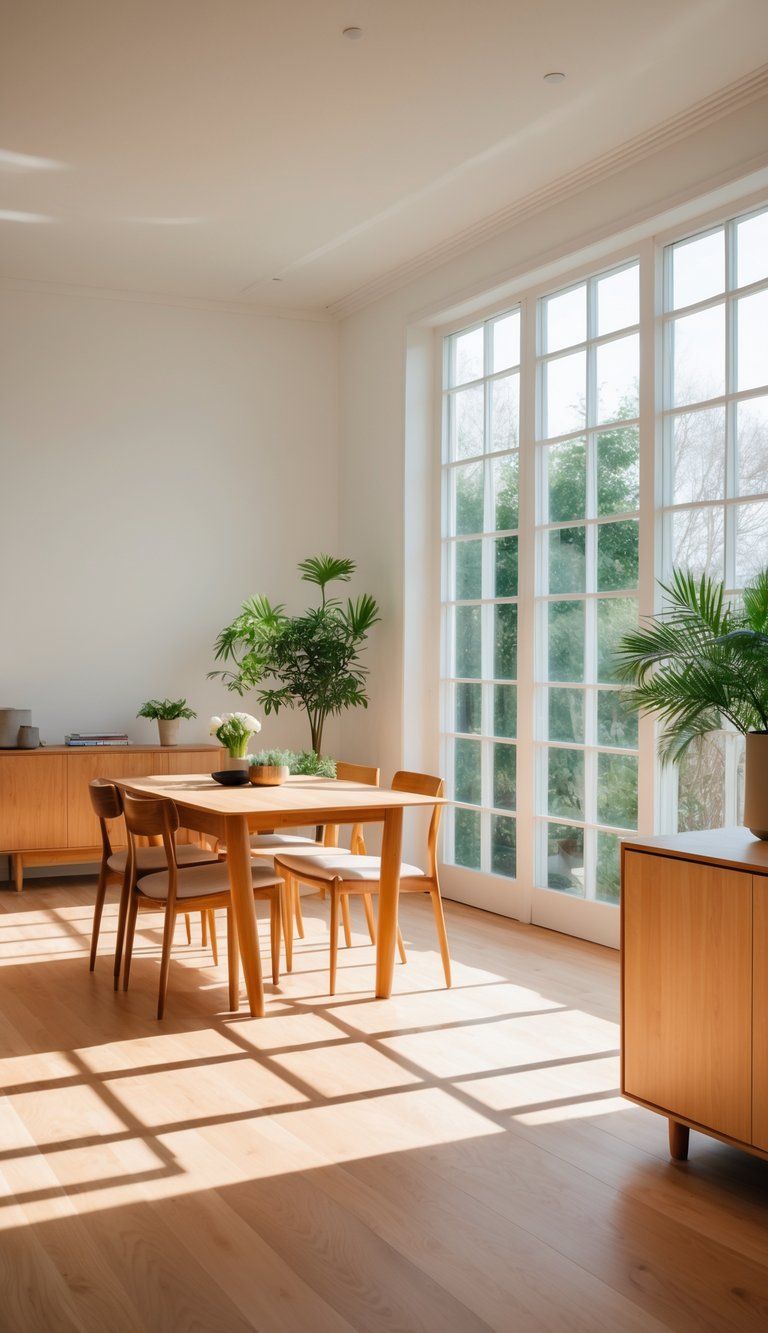
When you match wooden furniture with hardwood floors, the amount of light and the size of the room really matter. Light changes how colors look, and the room’s dimensions affect how furniture fits.
How Lighting Affects Color Perception
Natural light can totally change the look of wood tones throughout the day. North-facing rooms get cooler, bluish light, which makes warm woods like cherry seem a bit muted. South-facing spaces soak up warmer sunlight, bringing out red and yellow undertones in floors and furniture.
Morning light feels yellow, but by afternoon, things shift orange. That perfect oak table? It might look totally different at breakfast than at dinner.
Take some samples home before you commit to new wooden furniture. Check them out at different times of day, right where you’ll put them, to see how the colors actually interact.
Layer your lighting. Table lamps, floor lamps, and ceiling fixtures keep wood tones looking consistent, even when the sun isn’t cooperating.
Adaptations for Small or Large Spaces
In small rooms, you need to handle contrast carefully. Too much difference between floor and furniture can make the space feel choppy and even smaller.
Try these ideas:
- Pick furniture that’s just a bit lighter or darker than your floors—not a huge contrast.
- Go for pieces with legs so you can see more floor underneath.
- Choose fewer, multi-use pieces instead of a bunch of little ones.
For big rooms, you’ve got more freedom:
- Use area rugs to create zones under furniture groupings.
- Choose more substantial pieces so they don’t get lost in all that space.
- Try darker furniture with light floors (or the reverse) for a bold effect.
Scale matters, too. Low-profile furniture fits better in rooms with low ceilings. Taller pieces help balance out high ceilings. Bulky furniture needs some breathing room, so don’t crowd it.
Styling Tips for Various Furniture Styles
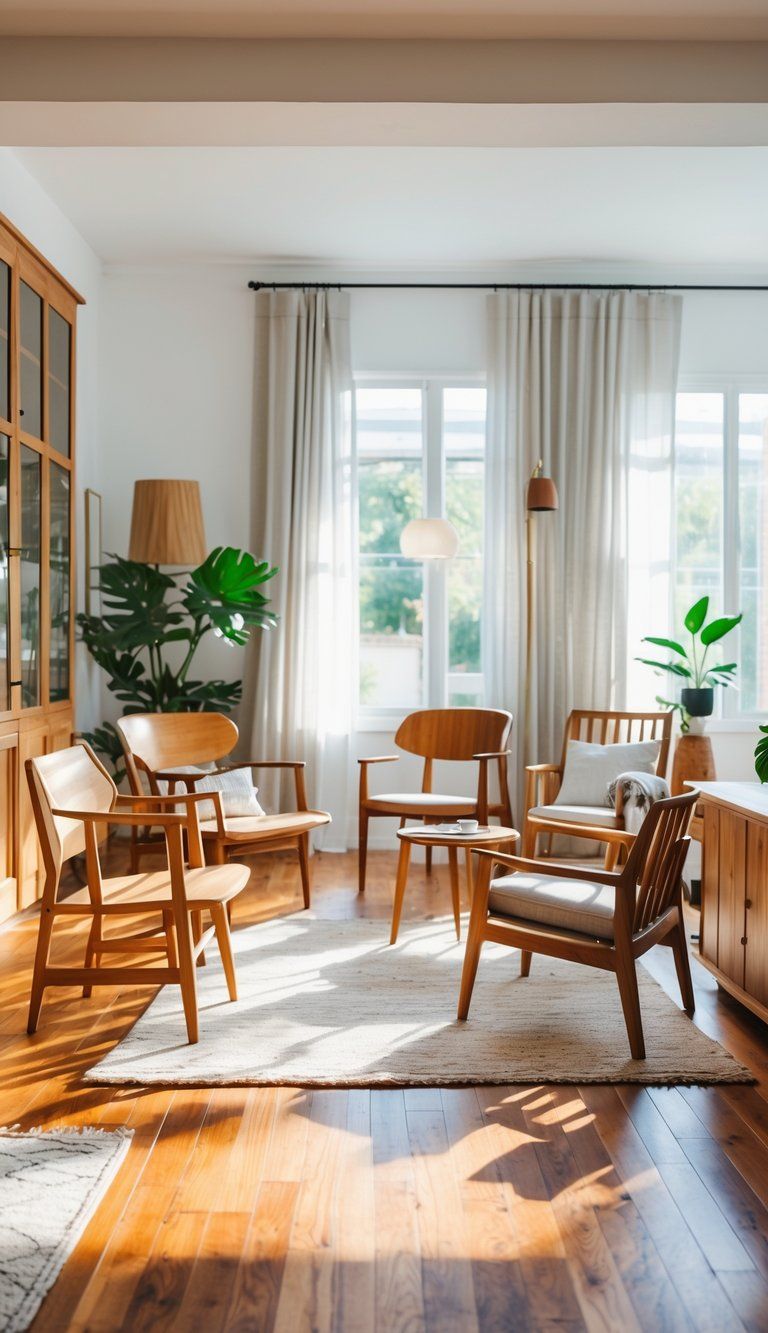
Different furniture styles can either complement or contrast with your hardwood floors in their own way. The trick is figuring out how to match each style’s features with your floor’s tone and finish.
Modern and Minimalist Approaches
Modern furniture looks best with clean lines and a bit of contrast. When you pair it with hardwood floors, pick pieces that either match the floor’s undertones or go for an intentional contrast.
If you’ve got light floors like maple or ash, try furniture with dark accents or black metal frames. It adds interest without overpowering the room.
With darker floors, you might want:
- Light-colored wooden furniture with simple shapes
- Glass or acrylic tables that seem to “float” above the floor
- Furniture with hairpin or slender metal legs
Stick to 2-3 core colors. Keeping the palette limited helps maintain a minimalist vibe and lets the furniture and floors stand out.
Matte finishes usually work better than high-gloss in modern rooms. They create a more relaxed, sophisticated balance with the wood.
Traditional and Rustic Pairings
Traditional and rustic furniture styles really show off wood’s natural beauty. You don’t need to match the tones exactly—just focus on complementary wood tones.
For oak or pine floors, cherry or walnut furniture adds some rich contrast. Look for:
- Furniture with visible grain patterns and natural finishes
- Pieces with curved details or turned legs
- Distressed or hand-scraped textures that echo the floor’s character
Mix in some upholstered items with natural fabrics like linen or cotton to soften all the wood.
Antiques can bring in history and depth when you place them on hardwood. Just make sure their wood tones fit in with your overall color story.
To keep a rustic look from getting too busy, stick to 2-3 wood species in the room. That way, you get harmony but still have some variety.
The Role of Area Rugs in Unifying Wood Elements
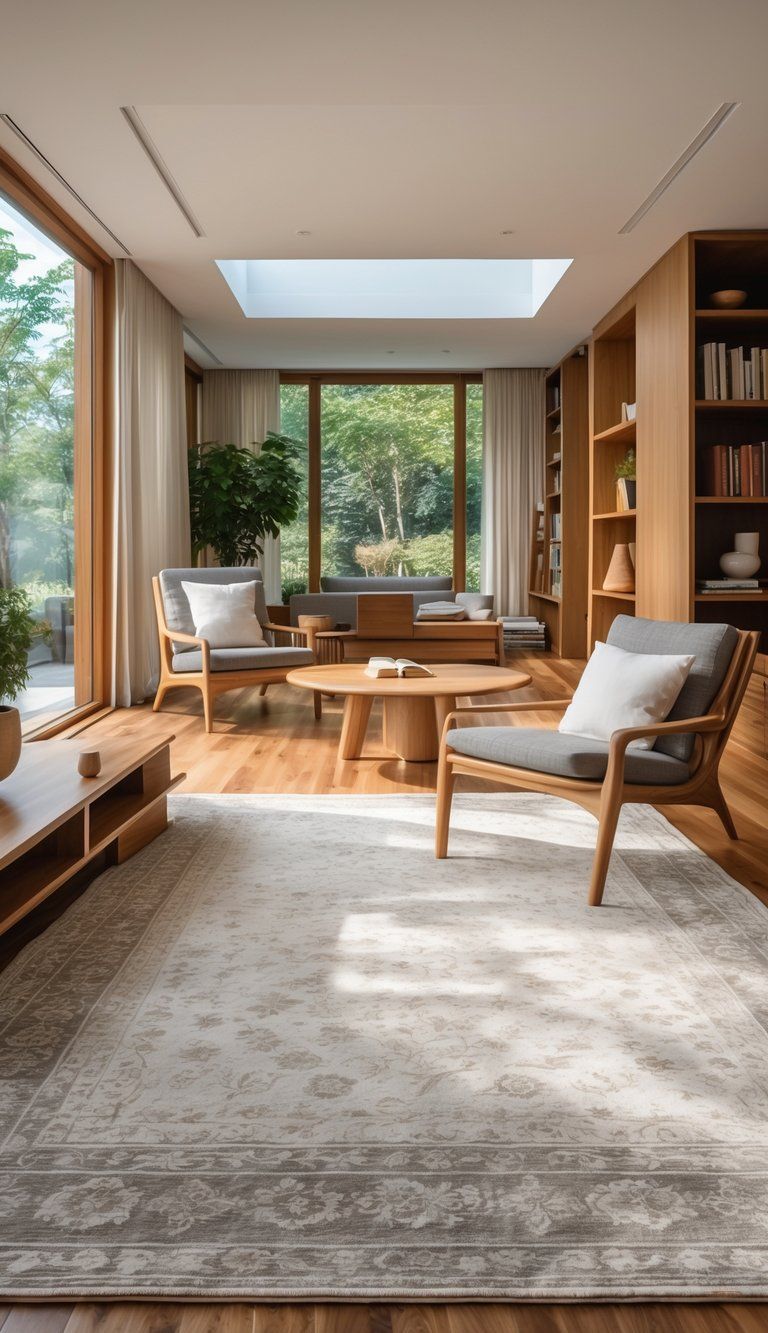
Area rugs do a lot to pull different wood tones together. They connect furniture and flooring and add comfort and style at the same time.
Choosing Area Rugs for Color Coordination
When you pick an area rug, start by looking at your hardwood floor’s color. The rug should work with the floor’s natural tone. Warm-toned floors like cherry or mahogany pair well with rugs in rust, amber, or cream.
If your wood’s cooler, like ash or maple, blue, gray, or sage green rugs look great. You don’t have to match exactly—just aim for harmony.
Size matters more than you’d think. A rug that’s too small can make the room feel disconnected. Ideally, all your furniture legs should fit on the rug, or at least the front ones.
Balancing Patterns and Textures
Area rugs bring in much-needed texture, especially in rooms filled with wood. This contrast keeps things from feeling flat and boring.
Try these texture combos:
- Plush, high-pile rugs soften up spaces with sleek, modern wood furniture.
- Flat-weave rugs go nicely with rustic or textured wood.
- Patterned rugs can help tie together wood tones that might otherwise clash.
In rooms with lots of wood, rugs break up all that visual weight. They give you some breathing space between the floors and furniture and keep things from feeling too heavy.
Patterns in rugs can echo design elements in your furniture, creating a sense of flow. Just watch out for patterns that fight with bold wood grain.
Common Mistakes to Avoid When Matching or Contrasting
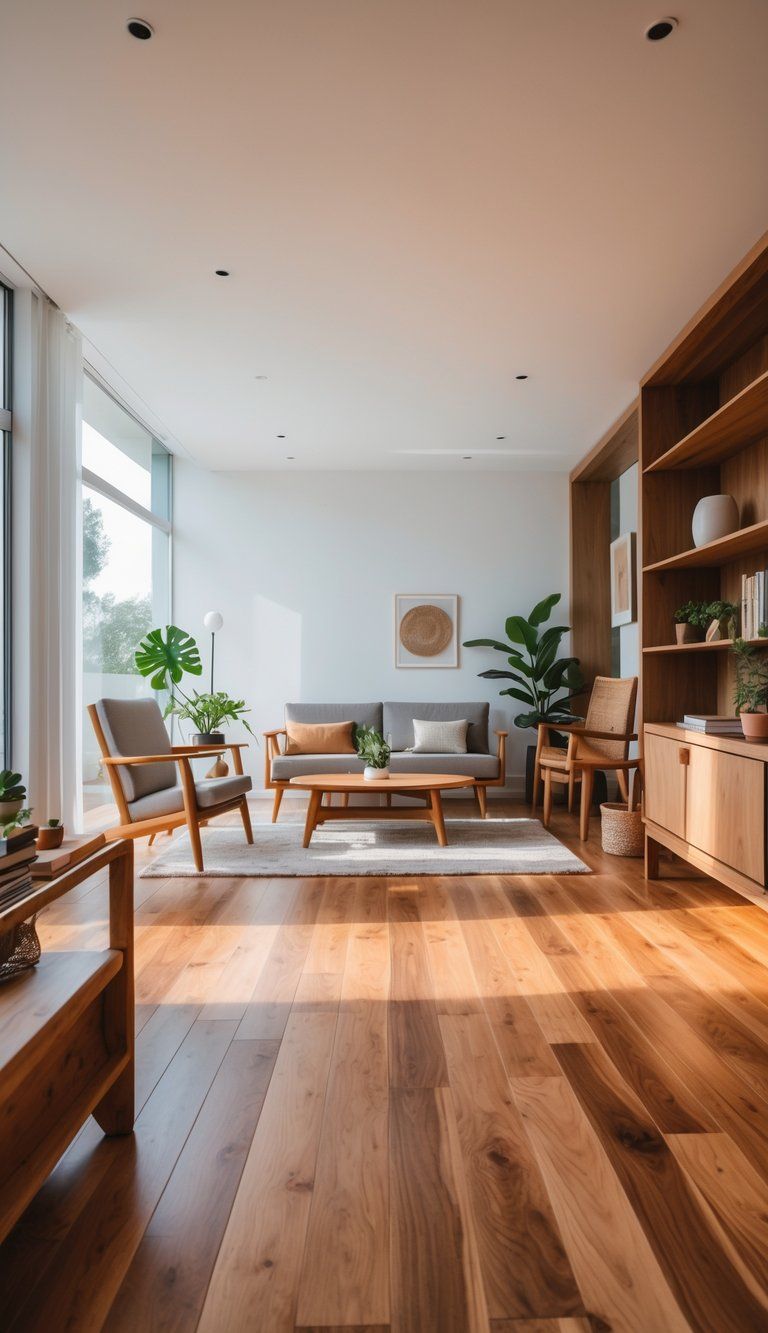
Even experienced designers mess up sometimes when they’re matching wood floors and furniture. Knowing what to avoid can save you a lot of frustration.
Ignoring Undertones and Overlooking Texture
One major mistake? Ignoring wood undertones. Oak usually has yellow or orange undertones, while walnut leans cooler and a bit purple-brown. If these clash, the room just feels off, even if you can’t say why.
Undertone Test: Put samples next to each other in different lighting (morning, afternoon, evening) before you decide.
Texture differences matter, too. Pairing a heavily distressed farmhouse table with smooth, modern floors creates awkward tension. High-gloss furniture with matte floors can look like a mistake instead of a design choice.
Think about:
- Wood grain pattern (tight or open)
- Surface treatment (smooth or distressed)
- Finish sheen (matte, satin, semi-gloss, high-gloss)
Overmatching or Over-Contrasting
If everything matches perfectly—floors, furniture, cabinets, even the trim—your space can end up flat and boring. That “showroom effect” just doesn’t feel personal.
But too much contrast isn’t great either. Pairing super dark furniture with very light floors (or the opposite) without something in between can feel harsh and disconnected.
The Rule of Three: Try to use at least three wood tones in a room for visual interest. For example:
- Medium-tone floors
- A slightly darker dining table
- Lighter accent pieces or trim
Balance really is everything. Use textiles, metal accents, and art to bridge strong wood tone differences and pull the space together.
Installing Hardwood Floors with Future Furniture in Mind

When you’re putting in new hardwood floors, it helps to think ahead about your furniture. Planning now means your floors will work with your style, even as it changes.
Planning Ahead for Changing Styles
Before you install hardwood, take a look at what furniture you already have—and what you might want to keep or swap out later.
Snap some photos of your furniture and bring samples with you when you shop for flooring. It’s way easier to picture how things will work together that way.
Go for versatile hardwoods like white oak or maple. These woods play nicely with lots of different furniture styles, so you can shift from modern to traditional without starting over.
Set aside a little budget for transition pieces like area rugs. They’re a lifesaver if you want to update your furniture before you’re ready to change out the floors.
Flexible Color and Tone Choices
Medium-toned hardwood floors—those not too light or too dark—give you a lot of flexibility with your furniture.
These finishes do a good job hiding dust and scratches. They also tend to work with both light and dark pieces.
I’d skip the trendy or really unusual stain colors. They can box you in when you want to change up your furniture later.
Natural wood tones just stay in style longer than colored stains, honestly.
If you want the most versatility, check out these hardwood options:
- White oak: Its neutral undertones play nicely with almost any furniture.
- Hickory: The natural variation fits a lot of different styles.
- Maple: Clean lines make it work for both contemporary and traditional looks.
Always test floor samples in your own home, and under different lighting. Something that looks great in the showroom can look totally different next to your stuff.
You don’t have to match wood floors and furniture exactly. In fact, going a few shades lighter or darker can make your space way more interesting.

